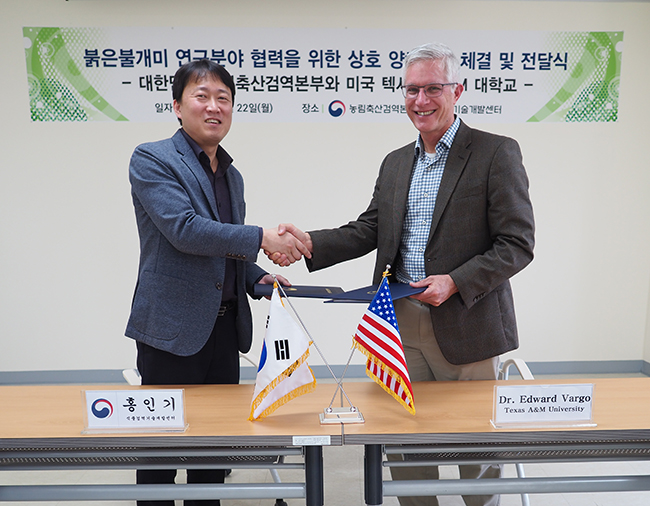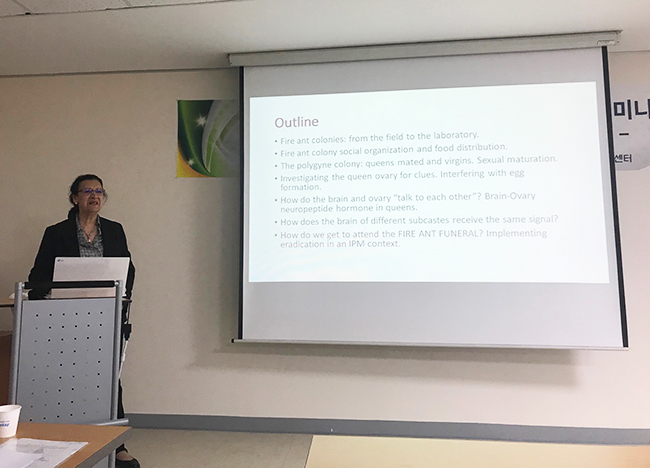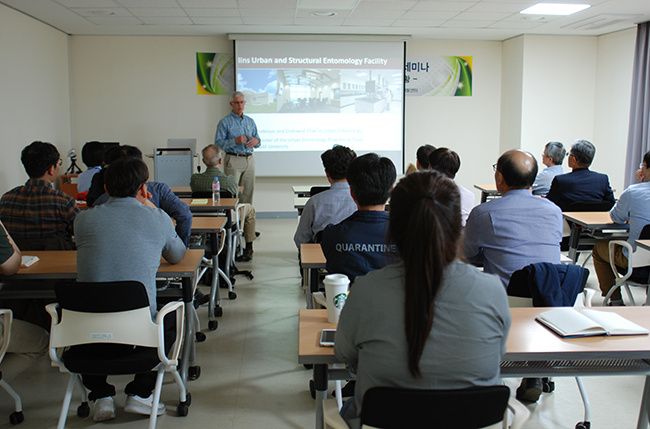
Young-tae Kim, Director of the Plant Pest Control Division with the Korean Animal and Plant Quarantine Agency (APQA), left, with Dr. Ed Vargo, Professor and Chair in Urban and Structural Entomology. Photo by the APQA
Two faculty members from the Department of Entomology at Texas A&M recently traveled to South Korea to help South Korean officials with a recent invasion of fire ants.
The group consisted of Dr. Patricia Pietrantonio, Professor and Texas A&M AgriLife Research Fellow, and Dr. Ed Vargo, Professor and Endowed Chair in Urban and Structural Entomology, who met with officials from South Korea.
The follow-up meeting this year stemmed from a request made in 2018 when researchers from the Korean Animal and Plant Quarantine Agency (APQA) requested help in finding ant experts to collaborate with to help control the invasive ants.
Entomologists from South Korea traveled to College Station in September 2018 to connect with and learn from experts in the areas of insect ecology, systematics, physiology, and genomics, as well as integrated pest management, of fire ants after they were reported in the port city of Busan in the southern part of South Korea.
During the meeting in South Korea in April 2019, Pietrantonio and Vargo discussed with the South Koreans the history of fire ant interceptions the country has faced and the role the Quarantine Service has done in their efforts to intercept them. They also listened to the South Korean’s efforts to test new insecticides and fumigants and for plans to create a genetic database for identifying the source of ants for future interceptions.

Dr. Patricia Pietrantonio speaking to the group about fire ants. Photo by APQA.
The group also toured the site at Incheon Port near Seoul where the first discovery was found. Vargo said the representatives from the APQA were very professional and he was very impressed with their handling of the situation.
“I was impressed with the knowledge and professionalism of the Animal and Plant Quarantine Agency (APQA) personnel in South Korea,” Vargo said. “They (APQA) are responsible for preventing the introduction of unwanted plants, animals, and plant diseases. They have recently intercepted several shipments containing the red imported fire ant. However, given the volume of cargo that come into South Korean ports, it will be a difficult task to find all containers that may have fire ants. They certainly have their work cut out for them.”
Pietrantonio was also impressed with APQA’s decision to seek help in controlling the ants by asking Texas A&M entomologists for their guidance – a invasive ant we have worked on for decades.

Dr. Ed Vargo speaking to the group. Photo by APQA
“The administrators and researchers in the Animal and Plant Quarantine were extremely appreciative and welcoming and they were genuinely concerned about the possible survival of the red imported fire ants throughout the winter, especially in the ports and other coastal areas where the soil temperature may have allowed their survival at a certain depth,” she said. “They are further concerned about not knowing currently the country or region of origin of the fire ants they have found, because their preliminary genetic analyses was not conclusive or matched fire ant populations that have been characterized elsewhere.”
The outcome of the meeting resulted in the group signing a memorandum of understanding for future research collaborations if needed.
“If the red imported fire ant continues to be found in South Korea, it is very likely that contacts will be reinitiated, especially to genetically compare Korean fire ant specimens with those across the USA and to determine the physiological changes that may allow fire ants to survive in South Korea,” Pietrantonio said.
